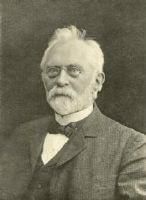Early life and family life
Warming was born on the small Wadden Sea island of Mandø as the only child of Jens Warming (1797-1844), parish minister, and Anna Marie von Bülow af Plüskow (1801-1863). After the early death of his father, he moved with his mother to her brother in Vejle in eastern Jutland.
He married Johanne Margrethe Jespersen (known as Hanne Warming; 1850-1922) on November 10, 1871. They had eight children: Marie (1872-1947) married C.V. Prytz, Jens Warming (1873-1939), who became a professor in economy and statistics at the Royal Veterinary and Agricultural College, fro (1875-1880), Povl (1877-1878), Svend Warming (1879-1982), engineer at Burmeister & wain shipyard, Inge (1879-1893), Johannes (1882-1970), farmer, and Louise (1884-1964).[3] External link: Ancestors and descendents[4]
Education and career
He attended high school at Ribe Katedralskole and commenced 1859 studies of natural history at the University of Copenhagen, but left university for three-and-a-half year (1863-1866) to act as secretary for the Danish palaeontologist Peter Wilhelm Lund, who lived and worked in Lagoa Santa, Brazil. After his return to Europe, he studied for a year under K.F.P. Martius, K.W. Nägeli and Ludwig Radlkofer in Munich and, in 1871, under J.L. von Hanstein in Bonn. Later in the same year (1871), he defended his Dr.Phil. thesis in Copenhagen.
The professorship in botany at the University of Copenhagen became vacant with the death of A.S. Ørsted and Warming was the obvious candidate for a successor. However, he was passed over and the chair given to the older, but much less productive and original Ferdinand Didrichsen. Warming then became docent of botany at the University of Copenhagen, the polytechnic (Polyteknisk Læreanstalt) and the Pharmaceutical College 1873-1882. He became professor in botany at Stockholms högskola (later Stockholm University) 1882-1885. As the eldest professor, he was elected rector magnificus.[5] In 1885, he became professor in botany at the University of Copenhagen and director of the Copenhagen Botanical Garden and held these positions until his retirement in December 31, 1910. He was rector magnificus of the University of Copenhagen 1907-1908.
He was a member of the Royal Danish Academy of Sciences and Letters from 1878 to his death. As such, he served on the board of directors of the carlsberg Foundation 1889-1921 and, because a biologist, on the board of the Carlsberg Laboratory. He also served on the board of the Geological Survey of Denmark 1895-1917.
Eugen Warming was a frequent visitor to foreign universities, e.g. a travel to Strasbourg and Paris in 1876 and another to Göttingen, Jena, Bonn, Strasbourg and Paris in 1880. He participated in several Scandinavian Scientist Conferences between 1868 and 1916 and in the similar German meeting in Breslau in 1874. He joined the International Botanical Congresses in Amsterdam 1877, in Vienna 1905 and in Brussels 1910 and was president of the ‘Association internationale des botanistes‘ (1913). He attended the Linnaeus celebration in Uppsala 1907 and the Darwin celebration in London 1908. He was honorary fellow of the Royal Society in London and honorary member of the Danish Botanical Society. He was a corresponding member of the botanical section of the French Academy of Sciences.[6] He was made Commander 1st Degree of the Order of the Dannebrog, Commander of the Royal Victorian Order and the Brazilian Imperial Order of the Rose. He is buried in Assistants Cemetery in Copenhagen.
Warming’s influence
Despite the language barrier, Warming’s influence on the development of ecology is remarkable, not the least in Britain and the USA. The British ecologist Arthur Tansley was extremely influenced by reading ’Plantesamfund’ (or rather the 1896 German edition). Reading the book made him jump from anatomy to ecology.[1] Tansley used the book as textbook in a university course as early as 1899.[10] Similarly, Warming's book was decisive in forming the careers of North American naturalists like Henry Chandler Cowles.[11] Cowles' now classic studies of Lake Michigan sand dune plant communities were directly inspired by Warming's studies of Danish dunes.[12] Also Frederic Clements was much inspired by Warming when starting to working with succession, but more by Oscar Drude in formulating his concept of vegetational climax in his 1916 book.
A more unexpected avenue of influence went through the American sociologist Robert E. Park, who read Warming's Oecology of Plants and used the ideas of ecological succession as inspiration for a notion of succession in human communities - a human ecology.[13]
Warming’s influence on later Scandinavian ecology was immense. Especially significant was his inspiration to christen Raunkiær � his pupil and successor on the chair of botany at the University of Copenhagen. In addition, he had a direct influence of Danish research, scientific and other, for a couple of decades. After his appointment to the professorship in Copenhagen, he gradually took over Japetus Steenstrups power base, most notably as one of three members of the board of the Carlsberg Foundation for 32 years. Thus, Warming had the upper hand in whom should be granted money and whom should not.
他最早在大學裡主講生態學課程,並界定生態學概念的意義與內容,一生寫了大量植物學、植物地理學和生態學的著作,先後被翻譯成多種語言,並對他的同代人和後來者產生了深遠的影響。有論者曾說:“如果要舉出一個人來不虧於生態學創立者的榮譽,瓦爾明顯然在最先考慮之列”。1895年,他發表劃時代的著作《以植物生態地理為基礎的植物分布學》(1909年出版英譯本時經改寫成《植物生態學》),書中系統整理了20世紀以前可以歸在生態學名下的知識,生態學成為一門現代科學肇始於此。
事業與勳章
1841年11月3日,瓦爾明出生在沃登(Wadden)海弗里西亞(Frisian)群島的芒弗(MandΦ)島,屬於什勒斯維希地方。父親詹斯・瓦爾明(1797-1844)是當地教區的牧師,母親名叫安娜・瑪麗・馮・布洛・布魯斯科(1801-1863)。3歲時,父親去世,他跟母親搬到日德蘭島東部的維澤勒(Vejle),去投靠他的舅舅。後來,他在古城力倍(Ribe)的教會學校(即著名的Ribe Katedralskole)上了高中,1859年進入哥本哈根大學開始學習自然史。
1863年,瓦爾明應選去了巴西的拉哥亞桑塔市(Lagoa Santa,一譯聖湖市,屬米納斯吉拉斯州)給在當地採集化石的丹麥化石學家倫德(Peter Wilhelm Lund)做秘書。登入巴西之後,在里約熱內盧經過短期的培訓,他騎在騾背上艱苦跋涉42天,到達拉哥亞桑塔的工作地――一個荒陋的小村莊。工作之餘,他獨自一人在當地進行徒步的自然史考察。當時拉哥亞桑塔的植物區系還是空白領域,而這個21歲的大學生手頭只有恩德利歇(Stephan Ladislaus Endlicher)的《植物屬志》和林德雷(John Lindley)的《植物界》,他唯以無可比擬的勤勉從事植物標本的採集。三年多的時間裡,儘管他閒暇時間不算多,交通也不便,他的足跡由住地向四面八方散發了約6公里遠,覆蓋了約100平方公里的地域,收集了2600種維管植物,其中有370種後來被發現是以前的科學完全沒有涉及的。
在拉哥亞桑塔期間,瓦爾明注意到,當地每年的旱季持續半年之久,接著是降水量高達1500毫米以上的雨季,而植物在這樣極端的氣候條件下表現出良好的適應性。他進而發現,植物的適應方式因種而異。由是,他認識到物種的獨立性,並開始嘗試解釋每個植物種的生活史。嚴重的乾旱導致全年更生具有選擇優勢,巴西的熱帶稀樹草原是一個顯例:隨處可見的蓮座狀植物,叢生植物和木質基部的多年生草本植物(按:xylopodial為暫譯,就此求教於方家)。正是從這種植物適應不良環境的種種表現方式中,他發現了某種具有普遍性的東西,即日後被他倚為生態學支點之一的“生活型”。這些早年的經驗對於他日後的工作可能是有決定意義的,而在拉哥亞桑塔所獲得的材料也終在30年後結出豐碩的研究成果。
1866年,瓦爾明回到歐洲,到慕尼黑跟隨博物學家瑪爾謝亞斯(Karl Friedrich Philipp Martius)、納吉里(Karl Wilhelm von Nägeli)和拉德爾科佛(Ludwig Adolph Timotheus Radlkofer)各學習了一年。這些年間,他致力於傳統的形態學研究並成為該領域出類拔萃的人物,同時與一些分類學家諸如艾希勒(August Wilhelm Eichler)和恩格勒(Heinrich Gustav Adolf Engler)聯繫與合作,嘗試把拉哥亞桑塔期間收集的大量植物種弄清楚,編撰了《巴西中部植物鑑定譜》40卷(有1400頁)。1871年,而立之年的瓦爾明又到波恩的漢斯坦(Johannes Ludwig Emil Robert von Hanstein)處學習顯微鏡技術。同年稍後,他在哥本哈根完成了博士論文答辯,論文題目是《大戟屬花或花序的“杯”:器官發生學與形態學研究》(註:大戟屬花序為聚傘花序,呈杯狀)。他終生都對花這一器官著迷不已,特別是胚珠部分。這一年,他與漢娜・瑪格麗特・雅斯貝森(後來即以漢娜・瓦爾明聞名)結婚。
當時,哥本哈根大學的植物學教授講席由於奧斯特(Anders Sandøe Ørsted)的逝世出現空缺,瓦爾明是被看好的一個接替者候選人。但是,他將這一席位讓給了老資格的戴里克森(Didrik Ferdinand Didrichsen),這位老先生其實缺乏創見也沒什麼成就。他自己在技術和製藥學院的編外教師職位上幹了近10年(1873-1882)。不過,這10年間他的思想發生了巨變,進化假說為他所接受,他的微觀研究事業漸漸從描述植物發育轉向了檢視植物結構與適應的關係。並且,從1878年起,掩不住鋒芒的他就進入了丹麥皇家科學與文學學會,並保持會員身份直到去世。1882年,他終在新成立的斯德哥爾摩學院(Stockholms högskola,即後來的斯德哥爾摩大學)成為植物學教授。作為深孚人望的教授,他又當選為該校的副校長。
1884年,瓦爾明去格棱蘭島和挪威的芬馬克考察了當時交通條件下可抵達的極端植被類型――苔原,並與拉哥亞桑塔的植被相比較,兩地生長季的類型與植物對不良季度反應方式對於他的生態學思想形成可能大有影響。此後,他的腳步所至,計有挪威多夫勒山(1885)、委內瑞拉和特立尼達(1887)、丹屬西印度群島(1891-1892)和法羅島(1895)等等。1895-1917年間,丹麥的地理大考察他也始終是組織或領隊人員之一。他的所有田野考察著意於發見植物與環境的關係,甚於發現新物種――他對為分類而分類的做法持強烈的批評態度。
1885年,哥本哈根大學的老先生戴里克森終於退休,瓦爾明獲得十多年前出讓的植物學教授席位,同時接任該校植物園主任。從此就一直擔任這兩個職務直到1911年退休。回到哥本哈根以後,植物群落的問題成為他首要致力的方向。其實,他在早年就已碰觸到如下的問題:植物個體(或群體)的結構與生理能力是否使得其機體(或群落)適應了在自然界所處的位置。在他的整個事業生涯中,他反覆地提出過該問題。這是一個關鍵的問題。在1886年接下來的5年內,他漸漸形成了如何研究植物分布的新觀點。1891年,他已經將這些觀點體系化,並在植物地理學的課堂上開講。講義在1895年整理出版,即《以植物生態地理為基礎的植物分布學》。他一生最重要的科學成就基本上凝結在此書之中。
迄於19世紀之末,瓦爾明超卓的科學成就已經使他躋身於歐洲第一流的科學家之列。同時,在大學的講台上與實驗室里,他也是一位嫻熟和熱忱的教師。除了《植物分布學》被認為是植物生態學領域的第一本教科書,發覆開新,倡生態學一時之盛,1880年出版的《普通植物學:中學和大學教程》和1990年的《植物的生活:中學和大學教程》(值得一提的是,該書丹麥文第四版是由他的學生拉恩基爾Christen Christensen Raunkiær與他合著的)也曾以不同語言多次重版。這些著作所裨益的範圍遠遠超出了哥本哈根大學的講台。瓦爾明的教學方法強調學生直面自然的觀察與實踐能力。在長期的田野與講台實踐中,他深感有必要帶領學生們走出課堂。執掌哥本哈根大學植物學講席以後,他就利用植物園向學生們展示植物機體,涉及植物生態則要求學生走向田野。但在哥本哈根周圍步行的活動範圍太促狹,於是他向政府申請並獲得一筆資金供每年帶領學生長途考察之用。從1893年起,他們每3年去一次西日德蘭,偶爾去過波恩霍爾姆和紐西蘭。他的考察記錄出版過,在介紹沙地、海灘等生境的環境與植物適應方面不乏啟發性。1907-1908年間,瓦爾明還擔任過哥本哈根大學的校長。
此外,瓦爾明還是卡爾斯堡基金會的董事(並因為專業生物學家的身份,成為卡爾斯堡實驗室的主管人員之一)、國際植物學會1913年屆的主席、倫敦皇家學會和丹麥植物學會的榮譽會員、法國科學院植物學部的通訊會員,曾被授予丹尼布洛一等勳章、維多利亞皇家勳章、巴西帝國玫瑰勳章、瑞典皇家科學院林耐大勳章。瓦爾明發現的植物種命名人的標準縮寫為Warm.,蘭科有一個Warmingia屬和幾十個種(比如Warmingia eugenii)以他命名,作為對他的紀念。
1924年4月2日,瓦爾明逝世,後葬於哥本哈根Assistants公墓。《自然》和《植物學雜誌》為他發布了訃告。

